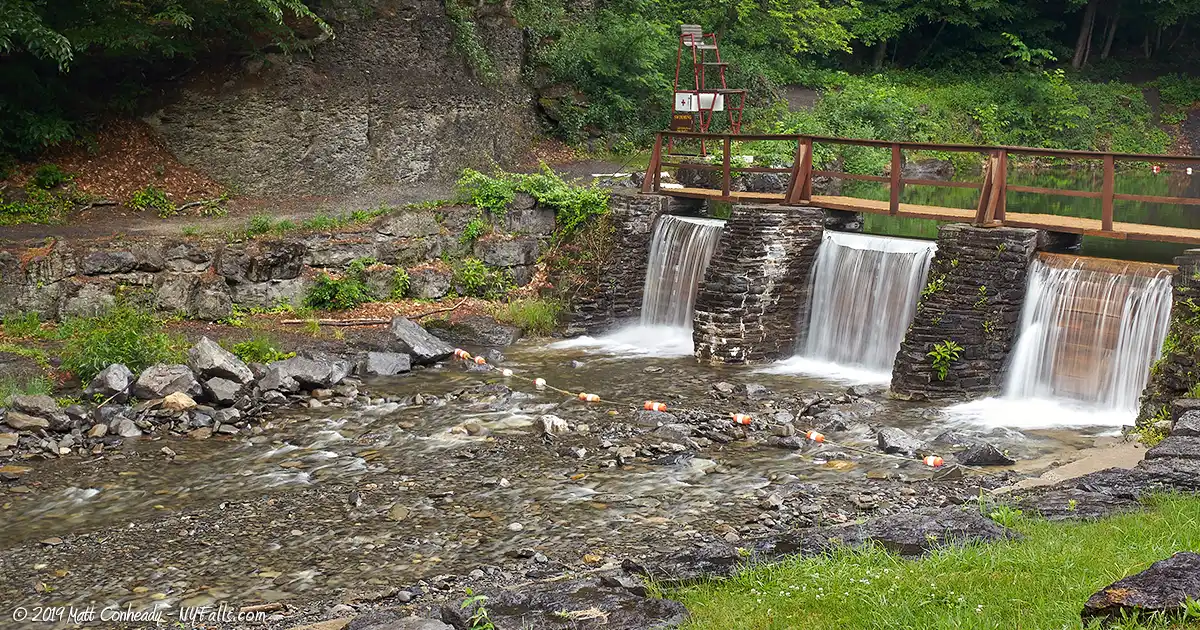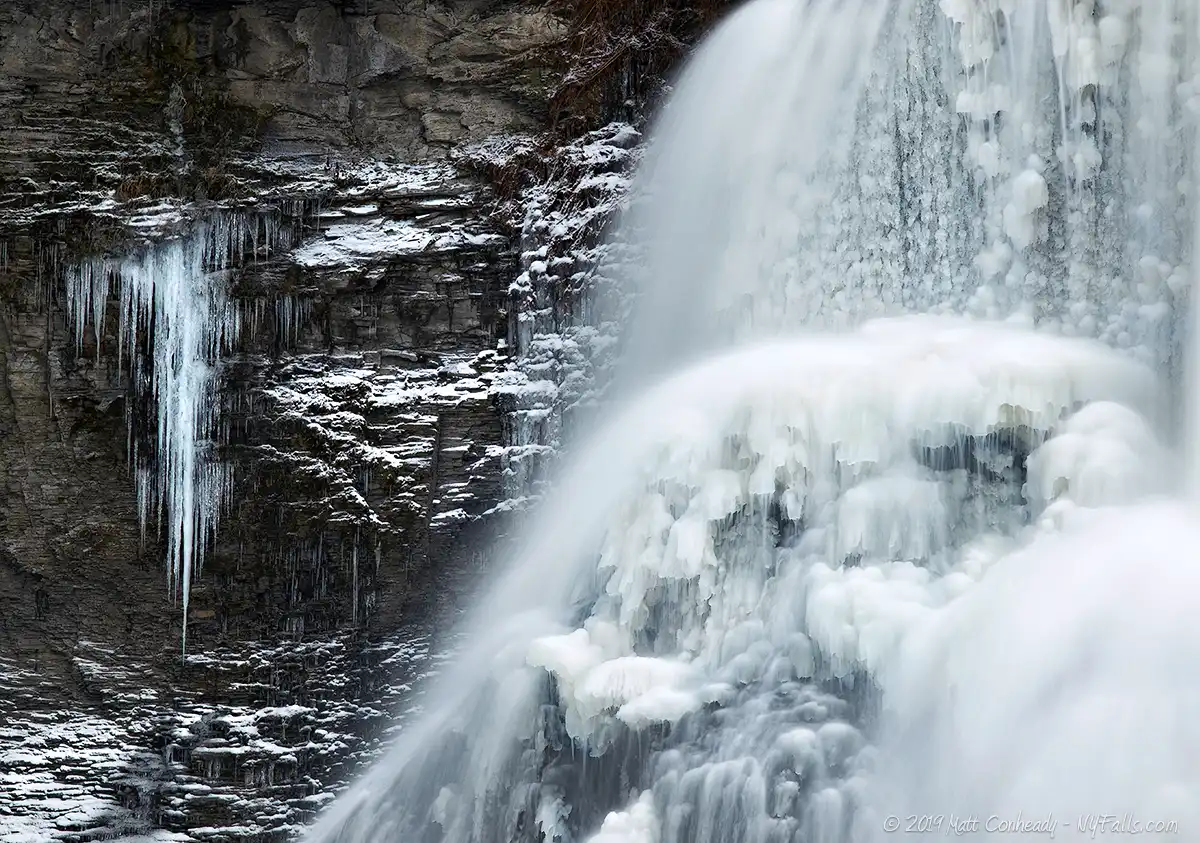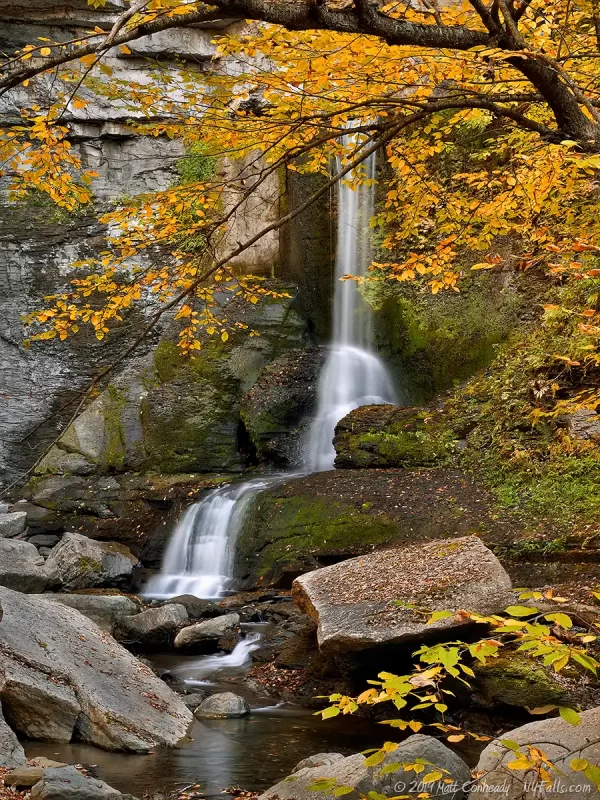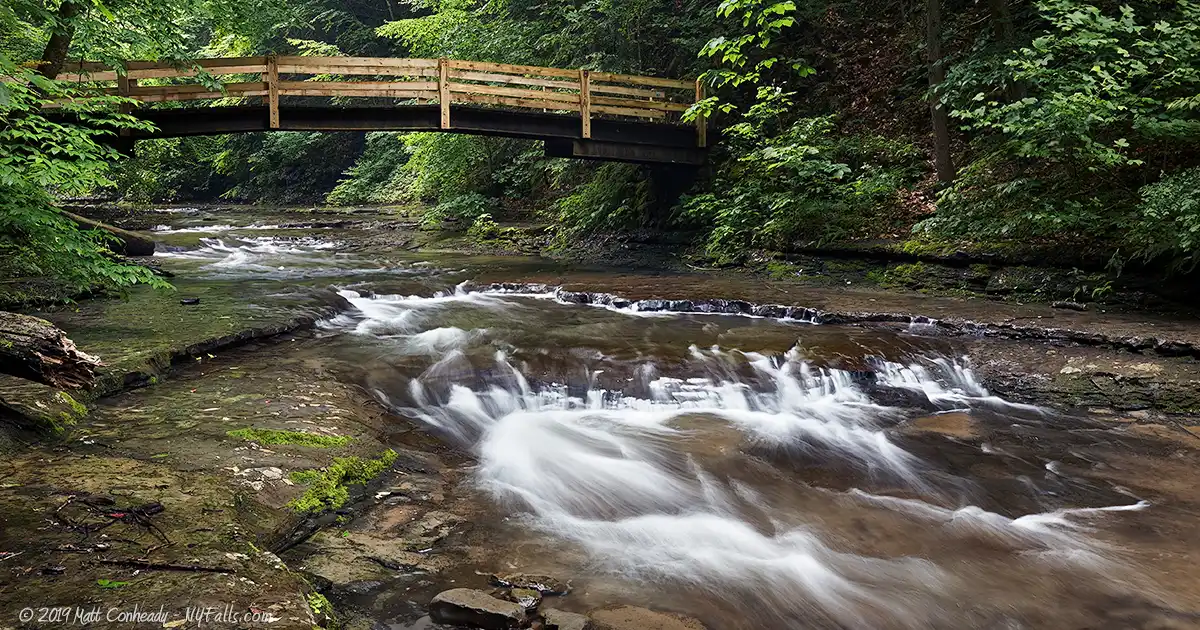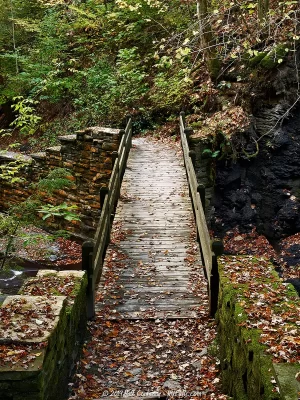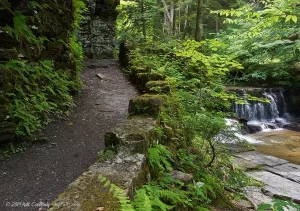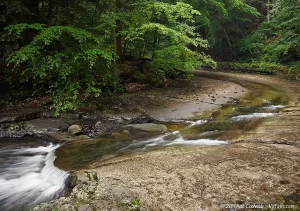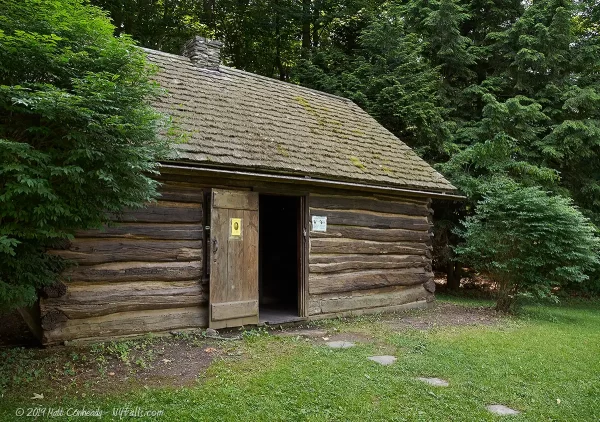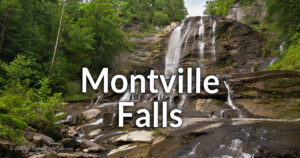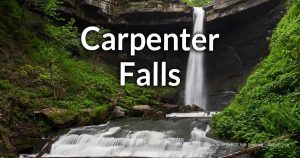Fillmore Glen State Park
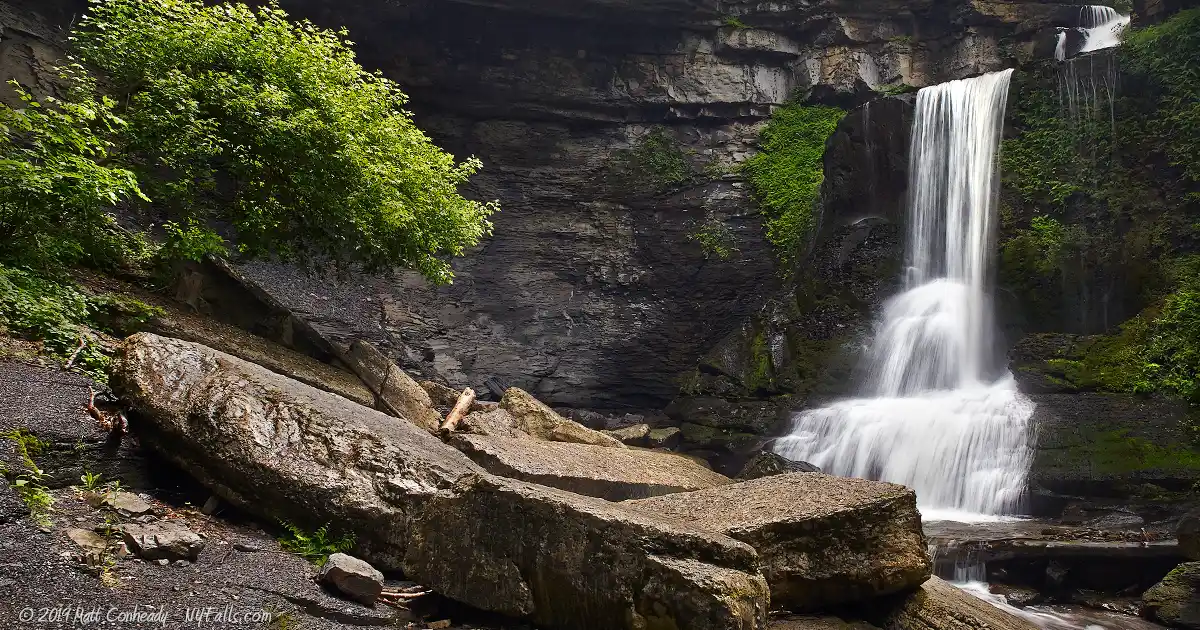
Location: Route 38, one mile south of Moravia. South of Owasco Lake, Cayuga County, New York.
Maps: Google Map; Topographic; Interactive; Trail Map; Campground Loop Map
GPS Coordinates:
- Park entrance: N 42.70013 / W 76.42000
- Swimming pool dam: N 42.69857 / W 76.41463
- Cow Shed Falls: N 42.69780 / W 76.41270
Directions: The park entrance is located off of NY-31 just south of the village of Moravia. When heading south from the village, the entrance will be on your left, across from the Dunkin Donuts.
Use Google Maps.
Parking: There are two large lots just past the entrance and before the swimming area. If one lot is full, cross the bridge over the creek to the other lot.
Weather

Information / Accessibility / Accommodations
Number of falls: 5 major waterfalls, various smaller cascades.
Size/Types: Ranging from 5-40 ft high. Cascades, punchbowls, plunges and chutes. Cowshed Falls (or Dry Falls) is about 30 ft high. The upper falls at the end of the gorge trail is around 40 ft.
Best time to visit: Year round. The park’s gorge trails are closed after November, but the Cowsheds Falls which is accessible ¼ of a mile from the parking lot is accessible year round. In cold weather, it becomes completely frozen over. In the wintertime, snowmobilers and cross-country skiers use the parks unplowed roads.
Flow: Variable, depending on rainfall. It will likely be very low by summer.
Waterway: Dry Creek, a tributary to the Owasco Inlet, with empties into Owasco Lake.
Time: 5 minutes for the Cowshed Falls – 2-3 hours for the rest of the gorge trail.
Seasons/Hours: Park open all year. Camping season from mid-May to mid-October. Gorge Trails close in winter.
Admission: $8 per vehicle (typically collected weekends and holidays from spring-fall, and daily during the peak season).
Handicap accessibility: Yes, the park’s west end is accessible, including the swimming area. The gorge trail is not.
Pets: Allowed on leash and with proof of inoculation. NOT allowed in the swimming area or on the gorge trail. This is for your pet’s safety and for the safety of other people hiking the gorge rim. Please do not bring your pets on the trail.
Swimming: Swimming in the dammed area when the lifeguard is on duty (typically Memorial Day weekend through Labor Day).
Camping: 3 cabins and 60 campsites. Camping is from May to November. Book a campsite.
Accommodations: pavilions; playgrounds; picnic tables; grills; swimming; showers; playing fields; hiking trails; bathrooms.
Description
Fillmore Glen is one of the many beautiful gorges in the Finger Lakes region. Out of all the surrounding parks (Buttermilk, Treman, Watkins Glen), Fillmore is the most rustic and closest to its natural state. Fillmore Glen is an oasis of cool, dense woods crowding into a long, narrow gorge. Its hiking trails offer magnificent views, distinctive geological characteristics (similar to Watkins Glen), including five major waterfalls within the glen. Of particular interest is the west end of the park, where a dam creates a refreshing natural pool for visitors to cool off in. Just about anyone can handle the short walk to Cowshed Falls, a 37 ft high waterfall in a secluded section of the gorge.
More adventurous visitors can hike upstream, passing numerous beautiful cascades along the mossy stonework of the gorge trail. With miles of trails within the park, the possibilities for hiking and photographing are astounding. Even in summer, the park doesn’t get as busy as some of the larger Finger Lakes parks and one can always find a secluded spot for some peace and quiet.
Fillmore Glen has 60 campsites, a stream-fed dammed swimming area, and plenty of places for picnicking. In the winter the park is often used for hiking, cross-country skiing and snowmobiling.
History
The village was settled as early as 1789, mostly by people from adjoining townships. Some of the first were Gideon Pitts and Jonathan Brownell from Genoa, and Jonathan Richmond of Ledyard. They found the flat meadowlands of the valley to be perfect for wheat and corn, but they then moved on. John Stoyel, a farmer from New England, moved to the valley in 1891, purchasing a large tract of land and became the first permanent settler, building the first mill on Mill Creek in the village. His brother and family followed 3 years after. Early settlers discovered a spring in the lowlands by the lake that spouted highly flammable carbureted water gas. As far as I can tell, it as never utilized in local industry.
Jethro Wood, a resident of Moravia, invented the first iron plow, complete with replaceable parts, in 1818. This invention caused a massive boost in American agriculture in mid 19th century, and his plow factory brought great prosperity to the town for some time. The prospering factory was eventually moved to a larger one at the base of Montville Falls.
A great flood hit the village in July of 1833 causing considerable damages to homes and business, completely destroying the plow factory.
The town of Moravia was established in 1833, carved out from the south part of the town of Sempronius. Moravia, New York, was named after the religious leader Jan Hus, who was from the region known as Moravia in what is now the Czech Republic.
Dry Creek (formerly “Dry Brook”) was named for its tendency to dry to a trickle by summer and some early accounts of the history of Moravia refer to the first waterfall (Cowshed Falls) as “Dry Falls” for that same reason.
The glen was long known for its abundant plant life and botanical diversity, prompting local governments to construct trails and maintain it as a park in the early 1920s. In 1925 the state acquired the land and established it as a State Park called “Glen State Park.” The park was then renamed after the 13th President of the United States, Millard Fillmore (who was born nearby) the glen now bears his name. President Fillmore was born just outside of Moravia, NY and married in a house that is still standing in the village. The park features a replica of his childhood cabin.
Fillmore Glen was the site of a Civilian Conservation Corps (CCC) camp in 1934-38, owing many of its stone walls and bridges to the CCC construction crews active during the Great Depression. The CCC is responsible for many State Park construction efforts including the beautiful stone masonry work found in such parks as Fillmore Glen, Watkins Glen and Letchworth.
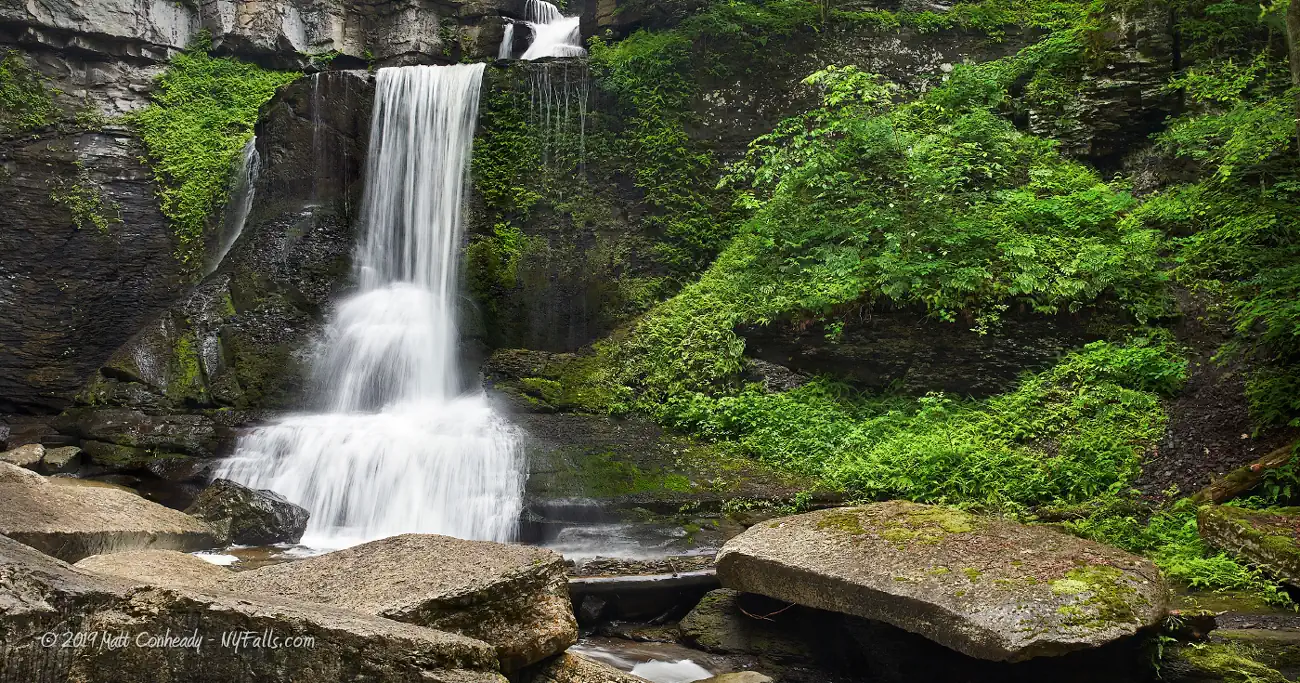
Hiking / Walking Trails
Difficulty: Easy, moderate, or difficult depending on how far you go.
Markings: State park signs and trail blazes.
Distance: A hike along the gorge trail is about a mile one way.
Trail guide: The lower waterfall (and tallest in the park) is located directly adjacent to the swimming area in the “Cowshed” area. It has paved trails and can be accessed by anyone by crossing the stone bridge and walking a couple of minutes. From the south side of the swimming area take the trail into the woods leading to the “Cowshed” and keep left.
The Gorge trail will get you to all the waterfalls outside of the Cowshed area. A full 1 mile hike to the end of the gorge trail will reward you with a view of the upper falls. Although the start of the trail is 150 ft climb up a wooded hill, once above the Cowshed area, the trail becomes a flat stone walkway. It winds around beautifully unique cascades along mossy stonework. Steps will get you above each of the falls and wooden bridges take you across the creek where necessary. In autumn this trail blooms with beautiful colors, and is one of the better hikes possible in that season.
Near the end of the gorge trail, it does become less defined and steep, without the stone walls, walkways and bridges that define the rest of the gorge trail. It ascends and joins with the South Rim Trail, which will lead back to the descent down the hill and to the parking area.
The North and South Rim Trails follow the gorge rim on their respective sides. These trails offer birds-eye views of some of the waterfalls.
Maps: Google Map; Topographic; Interactive; Trail Map; Campground Loop Map
Fillmore Glen Interactive Map
Fillmore Glen State Park Media
Fillmore Glen State Park Videos

Fillmore Glen Photo Gallery
Interesting Stuff
Millard Fillmore Importance
Millard Fillmore was the 13th President of the United States, serving from 1850 to 1853. He ascended to the presidency upon the death of President Zachary Taylor, under whom Fillmore had served as Vice President.
Born on January 7, 1800, in a log cabin in Moravia, Fillmore was the second of nine children. His early life was marked by poverty, and he had little formal education.
Despite these initial hardships, Fillmore managed to educate himself and became a teacher before beginning a law apprenticeship at the age of 19. He was admitted to the bar in 1823 and began a law practice in East Aurora, New York.
In terms of his political career, Fillmore was initially a member of the Anti-Masonic Party before joining the Whig Party. He served in the New York State Assembly and then in the U.S. House of Representatives. In 1848, he was elected as Vice President under Zachary Taylor.
Fillmore became President upon Taylor’s death in 1850. His presidency is often marked by the controversial Compromise of 1850, which included the Fugitive Slave Act, requiring that all escaped slaves, upon capture, be returned to their masters.
Fillmore was not nominated for the presidency in 1852 by the Whig Party, and he retired from politics after serving out his term.
After his political career, Fillmore was active in various civic activities, including the founding of the University at Buffalo. He died in Buffalo, New York, on March 8, 1874.
A replica of his childhood home is on display near the main parking area by the swimming pond. Yes, it was really that small. The cabin is usually open during peak tourist seasons.
Photography Tips
Capturing the falls
- By far – the easiest falls to photograph is the lower falls in the Cowsheds area because of the unique overhanging rock formation. Photographing these falls requires a wide-angle lens to get all the elements included in the picture.
- Some of the falls along the trail are located on the other side of the gorge, in a very steep area making photographing them without brush in the way impossible. It is NOT advisable to attempt to climb down into the water to get a shot. There is a lot of loose shale that crumbles very easily. Your best bet is to visit in late autumn before the trail closes, to capture the falls when the leaves are off the trees.
- The middle and upper falls are large and in the open, making photographing them and the surrounding gorge rather easy from the sides of the trail. A wide angle lens is a must to get the full breadth of the shot including the sheer rock walls.
Overcast skies
- Daylight will cast uneven shadows through the canopy and cause sunspots in your shots. It is best to wait for an overcast sky for this one.
Silky Water Effect
- To get that smooth cotton-candy look to the falls, you need to use a Neutral Density (ND) filter on your lens. The ND filter will block some of the light from entering the lens without altering the color, and thus allow your shutter to stay open longer. This blurs the water and creates a soft white gloss to the foamy areas of the falls. Check out the article for the all the details.
More tips
- See the Articles for more photography tips.
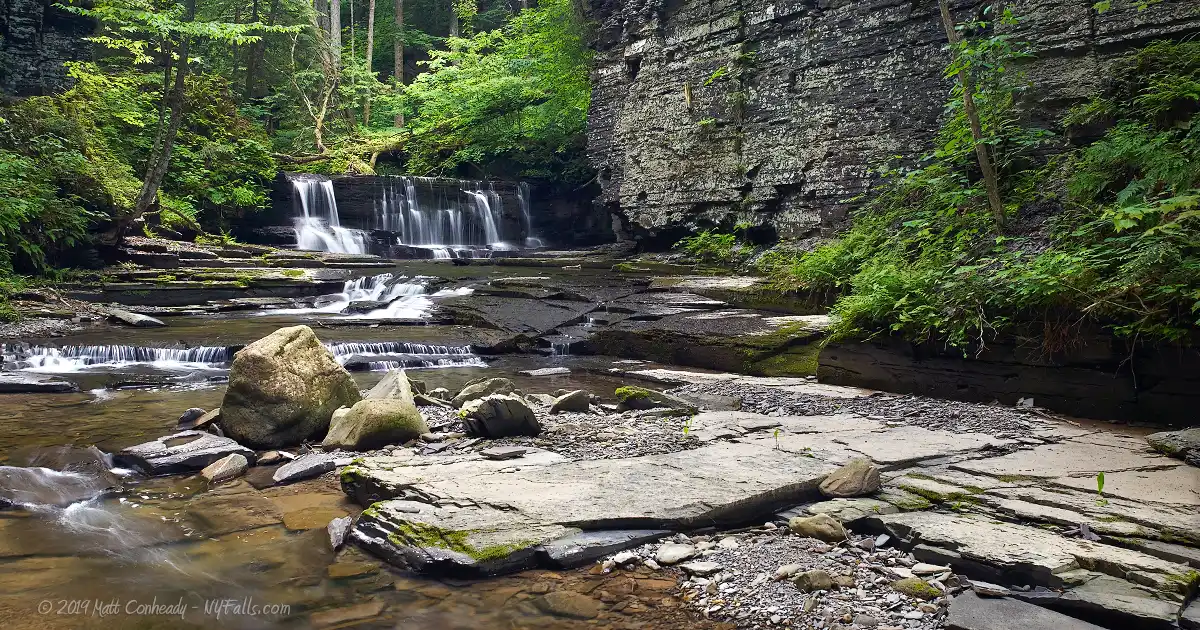
Who to Contact
Fillmore Glen State Park
1686 St. Rte. 38
Moravia, NY 13118
Phone: (315) 497-0130
[email protected]
